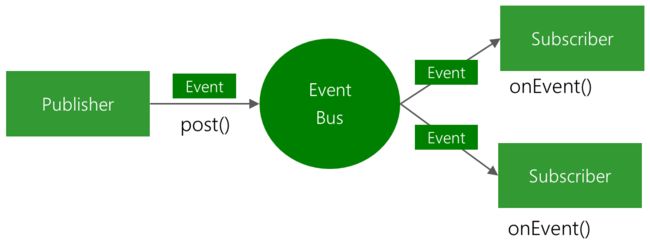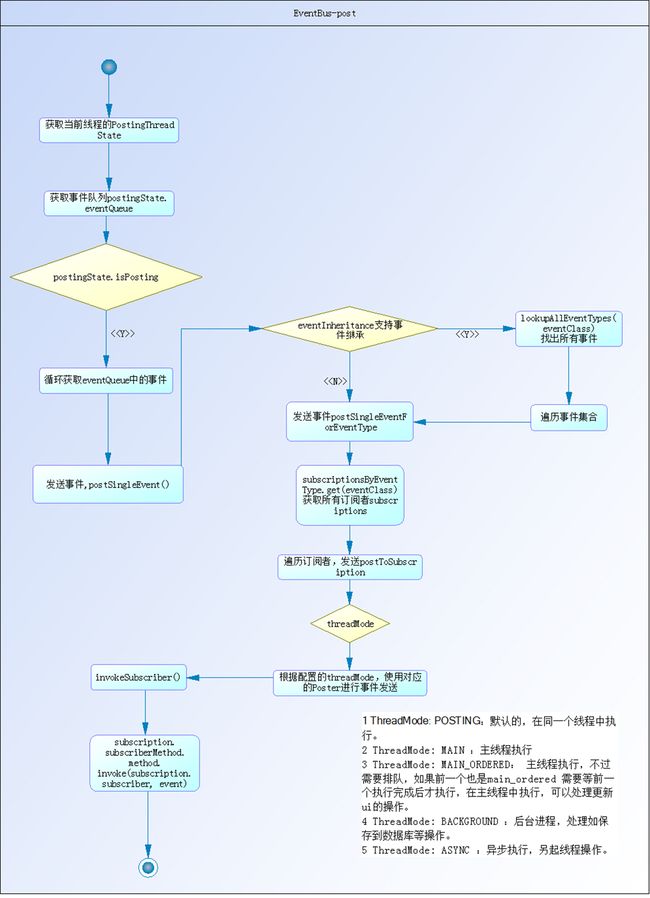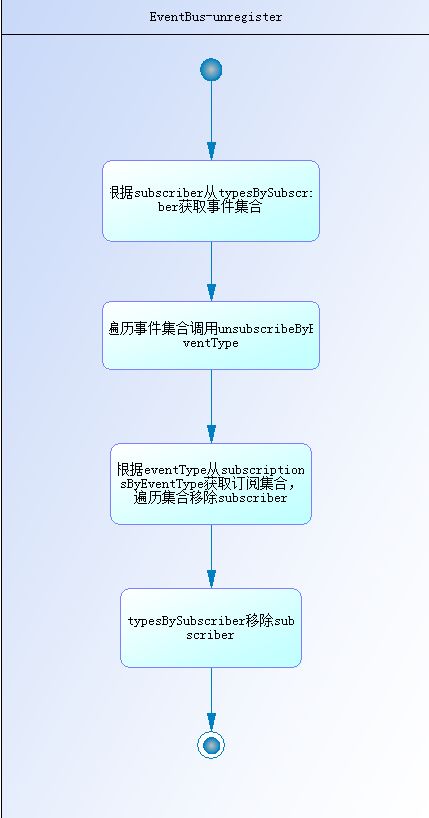EventBus是什么?
简介
EventBus是Android和Java的开源库,它使用发布者/订阅者模式进行松散耦合。EventBus使用了总线控制,能够用几行代码解耦类及简化代码,消除依赖关系,加速应用程序开发。
下图为官方示例图:
官网网址:EventBus官网
Github地址:Github
特点
- 简化组件之间的通信
- 发送者和接收者高度解耦
- 性能高效,社区活跃
- 库文件很小(<50KB)
- 具有简便配置线程、优先级等高级特性
EventBus怎么用?
1、gradle引入
implementation 'org.greenrobot:eventbus:3.1.1'
2、注册与取消注册
//注册
EventBus.getDefault().register(this);
//取消注册
EventBus.getDefault().unregister(this);
3、事件定义与发送
//定义
public class MessageEvent {
}
//发送
EventBus.getDefault().post(new MessageEvent());
4、事件接收
@Subscribe(threadMode = ThreadMode.POSTING)
public void onEventMainThread(MessageEvent event) {
// doSomeThing();
};
EventBus核心执行流程是怎样?
EventBus的使用包含注册、取消注册、事件定义发送及事件接收。当用户进行注册时,会通过反射获取实例中定义事件方法集合,然后将事件方法集合及订阅者加入到Map中,当执行post时,会根据事件类型,从集合中获取对应的订阅集合,通过配置的threadMode,使用对应的Poster调用订阅者的事件,最后通过反射method的invoke执行事件。
关键类功能说明
| 类 | 说明 |
|---|---|
| EventBus | 总线调度类,getDefault()为单例模式。内部持有订阅者及事件集合。还有各事件的发送器。eventTypesCache(缓存所有粘性事件的集合)、subscriptionsByEventType(key为事件,value为订阅者集合的Map)、typesBySubscriber(key为订阅者,value为事件集合的Map)、currentPostingThreadState(ThreadLocal,当前线程的事件集合)、mainThreadPoster(主线程的post)、backgroundPoster(后台线程的post)、asyncPoster(异步线程的post)、subscriberMethodFinder(获取订阅者中的事件) |
| SubscriberMethod | 订阅方法的类,包含Method、ThreadMode、priority等配置属性 |
| Subscription | 订阅者类,包含subscriber的Object实例、subscriberMethod |
| PostingThreadState | 存储当前线程的事件集合 |
| SubscriberMethodFinder | 用于获取订阅中的定义的事件接收方法 |
| PendingPost | subscription与event的包装类,内部维护一个pendingPostPool,当池中有PendingPost实例,会进行复用 |
| PendingPostQueue | 内部维护了一个head、tail的PendingPost实例,提供enqueue及poll操作 |
| HandlerPoster | 用于处理主线程的事件执行 |
| BackgroundPoster | 用于处理后台线程的事件执行 |
| AsyncPoster | 用于执行异步线程的事件执行 |
代码执行流程
注册-register
注册主要是通过反射获取订阅者中定义的事件方法集合,将订阅者和事件集合加入对应的Map,然后会判断是否支持粘性事件,将之前发送的粘性事件缓存发送给订阅者。
1、 源码实现
public void register(Object subscriber) {
//获取注册的Object的Class
Class subscriberClass = subscriber.getClass();
//通过subscriberMethodFinder获取该Object中所有的订阅方法(SubscriberMethod集合)
List subscriberMethods = subscriberMethodFinder.findSubscriberMethods(subscriberClass);
synchronized (this) {
//遍历事件集合
for (SubscriberMethod subscriberMethod : subscriberMethods) {
subscribe(subscriber, subscriberMethod);
}
}
}
private void subscribe(Object subscriber, SubscriberMethod subscriberMethod) {
Class eventType = subscriberMethod.eventType;
//生成Subscription对象(SubscriberMethod的包装类)
Subscription newSubscription = new Subscription(subscriber, subscriberMethod);
//获取subscriptionsByEventType集合(key为事情,value为订阅集合)
CopyOnWriteArrayList subscriptions = subscriptionsByEventType.get(eventType);
if (subscriptions == null) {
subscriptions = new CopyOnWriteArrayList<>();
subscriptionsByEventType.put(eventType, subscriptions);
} else {
if (subscriptions.contains(newSubscription)) {
throw new EventBusException("Subscriber " + subscriber.getClass() + " already registered to event "
+ eventType);
}
}
int size = subscriptions.size();
for (int i = 0; i <= size; i++) {
if (i == size || subscriberMethod.priority > subscriptions.get(i).subscriberMethod.priority) {
subscriptions.add(i, newSubscription);
break;
}
}
//获取typesBySubscriber集合(key为订阅者,value为事件集合)
List> subscribedEvents = typesBySubscriber.get(subscriber);
if (subscribedEvents == null) {
subscribedEvents = new ArrayList<>();
typesBySubscriber.put(subscriber, subscribedEvents);
}
//将所有的事件,根据订阅者key加入到事件集合中
subscribedEvents.add(eventType);
//事件方法是否支持(粘性事情)
if (subscriberMethod.sticky) {
//事件方法是否支持(继承事件)
if (eventInheritance) {
//遍历stickyEvents,找出所有继承于事件的父事件
Set, Object>> entries = stickyEvents.entrySet();
for (Map.Entry, Object> entry : entries) {
Class candidateEventType = entry.getKey();
if (eventType.isAssignableFrom(candidateEventType)) {
Object stickyEvent = entry.getValue();
//给订阅者发送之前缓存的粘性事件
checkPostStickyEventToSubscription(newSubscription, stickyEvent);
}
}
} else {
Object stickyEvent = stickyEvents.get(eventType);
//给订阅者发送之前缓存的粘性事件
checkPostStickyEventToSubscription(newSubscription, stickyEvent);
}
}
}
2、 流程图
发送-post
1、 源码实现
public void post(Object event) {
//获取当前线程的PostingThreadState
PostingThreadState postingState = currentPostingThreadState.get();
//获取事件队列postingState.eventQueue
List2、 流程图
取消注册-unregister
1、 源码实现
public synchronized void unregister(Object subscriber) {
//根据subscriber从typesBySubscriber获取事件集合
List> subscribedTypes = typesBySubscriber.get(subscriber);
if (subscribedTypes != null) {
//遍历订阅者的事件
for (Class eventType : subscribedTypes) {
unsubscribeByEventType(subscriber, eventType);
}
//typesBySubscriber移除subscriber
typesBySubscriber.remove(subscriber);
} else {
logger.log(Level.WARNING, "Subscriber to unregister was not registered before: " + subscriber.getClass());
}
}
private void unsubscribeByEventType(Object subscriber, Class eventType) {
//根据eventType从subscriptionsByEventType获取订阅集合
List subscriptions = subscriptionsByEventType.get(eventType);
if (subscriptions != null) {
int size = subscriptions.size();
for (int i = 0; i < size; i++) {
Subscription subscription = subscriptions.get(i);
if (subscription.subscriber == subscriber) {
//遍历集合移除当前的subscriber
subscription.active = false;
subscriptions.remove(i);
i--;
size--;
}
}
}
}
2、 流程图
EventBus如何识别类中定义的接收方法?
EventBus之所以如此流行,一个很重要的地方就是使用非常简便。我们只需要在类中定义好方法接收对应的事件、配置好相关的标注就可以。那么怎么获取到订阅者的事件方法集合,就是EventBus设计的一个精髓的地方。通过上面的注册方法,我们知道主要是通过下面的方法来获取,下面我们主要分析一下具体的实现。
List subscriberMethods = subscriberMethodFinder.findSubscriberMethods(subscriberClass);
接着看findSubscriberMethods的事件
List findSubscriberMethods(Class subscriberClass) {
//定义了缓存Map,避免每次都执行反射获取,提高性能
List subscriberMethods = METHOD_CACHE.get(subscriberClass);
if (subscriberMethods != null) {
return subscriberMethods;
}
if (ignoreGeneratedIndex) {
//通过反射获取
subscriberMethods = findUsingReflection(subscriberClass);
} else {
//通过索引获取
subscriberMethods = findUsingInfo(subscriberClass);
}
if (subscriberMethods.isEmpty()) {
throw new EventBusException("Subscriber " + subscriberClass
+ " and its super classes have no public methods with the @Subscribe annotation");
} else {
METHOD_CACHE.put(subscriberClass, subscriberMethods);
return subscriberMethods;
}
}
最后会执行indUsingReflection去获取,具体实现如下:
private List findUsingReflection(Class subscriberClass) {
//FindState 用来做订阅方法的校验和保存
FindState findState = prepareFindState();
findState.initForSubscriber(subscriberClass);
while (findState.clazz != null) {
//通过反射来获得订阅方法信息
findUsingReflectionInSingleClass(findState);
//查找父类的订阅方法
findState.moveToSuperclass();
}
return getMethodsAndRelease(findState);
}
关键的实现在findUsingReflectionInSingleClass方法中,实现如下:
private void findUsingReflectionInSingleClass(FindState findState) {
Method[] methods;
try {
// //通过反射得到方法数组
methods = findState.clazz.getDeclaredMethods();
} catch (Throwable th) {
// Workaround for java.lang.NoClassDefFoundError, see https://github.com/greenrobot/EventBus/issues/149
methods = findState.clazz.getMethods();
findState.skipSuperClasses = true;
}
//遍历Method
for (Method method : methods) {
int modifiers = method.getModifiers();
if ((modifiers & Modifier.PUBLIC) != 0 && (modifiers & MODIFIERS_IGNORE) == 0) {
Class[] parameterTypes = method.getParameterTypes();
////保证必须只有一个事件参数
if (parameterTypes.length == 1) {
Subscribe subscribeAnnotation = method.getAnnotation(Subscribe.class);
//得到注解
if (subscribeAnnotation != null) {
Class eventType = parameterTypes[0];
//校验是否添加该方法
if (findState.checkAdd(method, eventType)) {
ThreadMode threadMode = subscribeAnnotation.threadMode();
//实例化SubscriberMethod对象并添加
findState.subscriberMethods.add(new SubscriberMethod(method, eventType, threadMode,
subscribeAnnotation.priority(), subscribeAnnotation.sticky()));
}
}
} else if (strictMethodVerification && method.isAnnotationPresent(Subscribe.class)) {
String methodName = method.getDeclaringClass().getName() + "." + method.getName();
throw new EventBusException("@Subscribe method " + methodName +
"must have exactly 1 parameter but has " + parameterTypes.length);
}
} else if (strictMethodVerification && method.isAnnotationPresent(Subscribe.class)) {
String methodName = method.getDeclaringClass().getName() + "." + method.getName();
throw new EventBusException(methodName +
" is a illegal @Subscribe method: must be public, non-static, and non-abstract");
}
}
}
总结一下,EventBus是通过反射getDeclaredMethods()获取类的方法集合,然后遍历方法集合,将符合事件定义的方法(public、只有一个事件参数、有Subcribe的注解等)加入到集合中。从而达到识别订阅者中定义的事件方法。
EventBus中的线程调度机制是怎么样的?
我们知道,EventBus可以通过定义threadMode来指定事件回调的执行线程。主要的配置如下:
ThreadMode: POSTING:默认的,在同一个线程中执行。
ThreadMode: MAIN :主线程执行
ThreadMode: MAIN_ORDERED: 主线程执行,不过需要排队,如果前一个也是main_ordered 需要等前一个执行完成后才执行,在主线程中执行,可以处理更新ui的操作。
ThreadMode: BACKGROUND :后台进程,处理如保存到数据库等操作。
ThreadMode: ASYNC :异步执行,另起线程操作。
通过上面的流程分析在post的过程中,最后都是通过postToSubscription执行,在这里面判断了threadMode的类型,具体的实现如下:
private void postToSubscription(Subscription subscription, Object event, boolean isMainThread) {
//根据对应的threadMode,使用对应的post进行事件的处理
switch (subscription.subscriberMethod.threadMode) {
case POSTING:
invokeSubscriber(subscription, event);
break;
case MAIN:
if (isMainThread) {
invokeSubscriber(subscription, event);
} else {
mainThreadPoster.enqueue(subscription, event);
}
break;
case MAIN_ORDERED:
if (mainThreadPoster != null) {
mainThreadPoster.enqueue(subscription, event);
} else {
// temporary: technically not correct as poster not decoupled from subscriber
invokeSubscriber(subscription, event);
}
break;
case BACKGROUND:
if (isMainThread) {
backgroundPoster.enqueue(subscription, event);
} else {
invokeSubscriber(subscription, event);
}
break;
case ASYNC:
asyncPoster.enqueue(subscription, event);
break;
default:
throw new IllegalStateException("Unknown thread mode: " + subscription.subscriberMethod.threadMode);
}
}
1、POSTING模式,直接执行invokeSubscriber。
2、MAIN模式,如果判断当前线程是主线程则执行invokeSubscriber,否则会使用mainThreadPoster执行enqueue方法。mainThreadPoster为HandlerPoster的实例,继承了Handler,是使用了MainLooper进行创建,也就是其的handleMessage在主线程中执行。
我们看具体的实现:
public void enqueue(Subscription subscription, Object event) {
//构建PendingPost对象
PendingPost pendingPost = PendingPost.obtainPendingPost(subscription, event);
synchronized (this) {
//加入队列
queue.enqueue(pendingPost);
//如果没有激活hander
if (!handlerActive) {
handlerActive = true;
//发送消息
if (!sendMessage(obtainMessage())) {
throw new EventBusException("Could not send handler message");
}
}
}
}
@Override
public void handleMessage(Message msg) {
boolean rescheduled = false;
try {
long started = SystemClock.uptimeMillis();
while (true) {
//循环获取队列中的所有pendingPost
PendingPost pendingPost = queue.poll();
if (pendingPost == null) {
synchronized (this) {
pendingPost = queue.poll();
if (pendingPost == null) {
//如果已没有数据,更新 handlerActive
handlerActive = false;
return;
}
}
}
//在主线程中实现事件的方法
eventBus.invokeSubscriber(pendingPost);
long timeInMethod = SystemClock.uptimeMillis() - started;
if (timeInMethod >= maxMillisInsideHandleMessage) {
if (!sendMessage(obtainMessage())) {
throw new EventBusException("Could not send handler message");
}
rescheduled = true;
return;
}
}
} finally {
handlerActive = rescheduled;
}
}
HandlerPoster会通过主线程的Handler去执行队列中的所有事件方法。
3、MAIN_ORDERED模式 优先主线程队列执行
if (mainThreadPoster != null) {
mainThreadPoster.enqueue(subscription, event);
} else {
// temporary: technically not correct as poster not decoupled from subscriber
invokeSubscriber(subscription, event);
}
4、BACKGROUND模式 如果再主线程则执行后台线程执行,否则使用当前线程
if (isMainThread) {
backgroundPoster.enqueue(subscription, event);
} else {
invokeSubscriber(subscription, event);
}
这里我们主要看backgroundPoster的实现,BackgroundPoster继承了Runnable,实现线程池执行run方法,通过executorRunning控制不会每次都启动一个新任务。
public void enqueue(Subscription subscription, Object event) {
PendingPost pendingPost = PendingPost.obtainPendingPost(subscription, event);
synchronized (this) {
//加入队列
queue.enqueue(pendingPost);
//变量标识,不要每次都执行
if (!executorRunning) {
executorRunning = true;
//线程池执行
eventBus.getExecutorService().execute(this);
}
}
}
@Override
public void run() {
try {
try {
while (true) {
//循环间隔1s获取事件
PendingPost pendingPost = queue.poll(1000);
if (pendingPost == null) {
synchronized (this) {
// Check again, this time in synchronized
pendingPost = queue.poll();
if (pendingPost == null) {
//如果已没有任务,更新变量
executorRunning = false;
return;
}
}
}
//在异步线程执行了事件方法
eventBus.invokeSubscriber(pendingPost);
}
} catch (InterruptedException e) {
eventBus.getLogger().log(Level.WARNING, Thread.currentThread().getName() + " was interruppted", e);
}
} finally {
executorRunning = false;
}
}
backgroundPoster会开启一个线程去执行当前所有队列中的事件方法。
5、ASYNC 模式 主要使用了AsyncPoster,也继承了run接口。实现如下:
public void enqueue(Subscription subscription, Object event) {
PendingPost pendingPost = PendingPost.obtainPendingPost(subscription, event);
queue.enqueue(pendingPost);
eventBus.getExecutorService().execute(this);
}
@Override
public void run() {
PendingPost pendingPost = queue.poll();
if(pendingPost == null) {
throw new IllegalStateException("No pending post available");
}
eventBus.invokeSubscriber(pendingPost);
}
AsyncPoster每一个事件都会开启一个异步任务,通过线程池去执行。
总结一下
EventBus通过配置threadMode,控制事件在不同的线程中去执行。总归有5种模式,分别为POSTING、MAIN、MAIN_ORDERED、BACKGROUND、ASYNC。主要是通过HandlerPoster、backgroundPoster、AsyncPoster来实现线程的切换。
- HandlerPoster会通过主线程的Handler开启循环去执行队列中的所有事件方法。
- backgroundPoster会开启一个线程循环执行当前所有队列中的事件方法。
- AsyncPoster每一个事件都会开启一个异步任务,通过线程池去执行。
EventBus的事件发送和接收的原理是什么?
EventBus主要是通过观察者模式来实现事件的发送和接收。使用register后,会将订阅者及定义的事件接收方法加入到Map中,当在任意地方执行post时,会对事件类型进行匹配,找出所有的订阅者,根据配置的threadMode,使用不同的poster通过反射去执行事件方法。当使用unregister后,会将订阅者在Map中移除,进行取消注册。
EventBus中代码运用了那些设计模式,有什么巧妙的设计?
1、单例模式
EventBus.getDefault()使用了懒汉的单例模式。
2、外观模式
EventBus对外提供了统一的调度,屏蔽了内部的实现。
3、建造者模式
Event对象的创建使用EventBusBuilder进行创建,将复杂对象的创建和表示分离,调用者不需要知道复杂的创建过程,使用Build的相关方法进行配置创建对象。
4、策略模式
根据threadMode的设置,使用不同Poster的实现策略来执行事件方法
总结
1、框架的设计不在复杂而在精巧
2、使用反射和标注可以简化很多实现
3、EventBus的使用要注意避免大量的滥用,将导致逻辑的分散,出现问题后很难定位
关于
欢迎关注我的个人公众号
微信搜索:一码一浮生,或者搜索公众号ID:life2code
- 作者:黄俊彬
- 博客:junbin.tech
- GitHub: junbin1011
- 知乎: @JunBin




